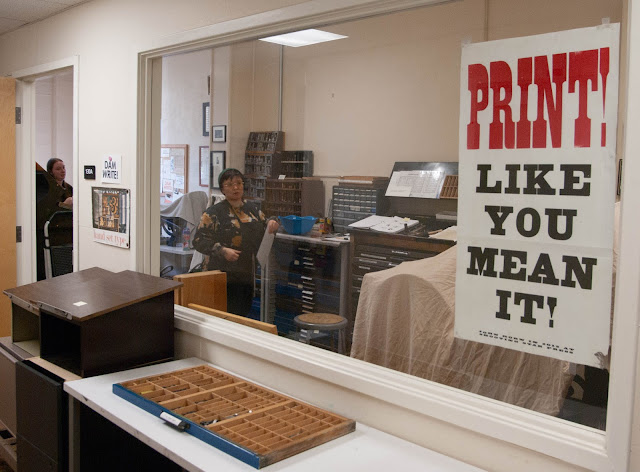WEEK X: FINAL PROJECT
March 5, 2024
I found myself in the OSU letterpress studio located on the garden level of Moreland Hall, home to the School of Writing, Literature and Film. Students gain access to the letter press studio by taking a 10 hour weekend workshop with Dr. Karen Holmberg. I was fortunate enough to gain my own access through Ellison Rose, an MFA student who had previously taken the workshop and was now able to freely use the studio to create their own projects.

Letterpress is an outdated printing technology and is now used primarily by artists.
As an artist themself, Ellison says they are drawn to this printing processes because of it's "tactile nature" They say, "It's like listening to music live -- someone's hands are interacting with a series of strings and a perfectly shaped piece of wood to create the sound that you hear. The letterpress is the same -- I get to use my hands to choose and set these pieces of metal, slather them in ink, and press them into paper. Working with words is usually so cerebral, but this is very physical."
Ellison's process begins by finding the perfect image from the catalog of "cuts'', the name given to the larger blocks with images on them. Each cut is made of lead nailed to a wooden block. The selections are very limited so the artists have to shape their designs around what is available to them. Ellison considered a few different images before landing on this one.
After selecting the image, the text is next. They first begin by choosing a "type case," a drawer of metal type in a font and size that compliments their image. Then they meticulously set the words on a composing stick one "sort," or letter, at a time. The entire image is constructed upside down, but with practice an artist can set type quickly by paying close attention to notches cut into the type called "nicks."
Now that the design is set and secured, it is moved from the composing stick to a "galley," the metal tray that houses the text during printing. Magnets are placed around the type to secure it in place and ink is applied to the design. Inking requires a light touch. Too much and the image becomes too blurry. Too little and there will be gaps in the final image. It takes a few sample prints to find the right balance, but Ellison is tenacious and eventually produces a perfect print.
This project is a gift for one of Ellison’s classmates. They say they were inspired to make this print when the classmate “recently included this fragment from Marilyn Monroe’s journals — my body is my body/every part of it — in one of her own essays. Marilyn almost feels like an idea at this point, like she belongs to the world. But she was a person with a body; it wasn’t her but it was hers. I just really appreciated my friend sharing Marilyn’s words through her art and I wanted to honor them as well.”





Comments
Post a Comment